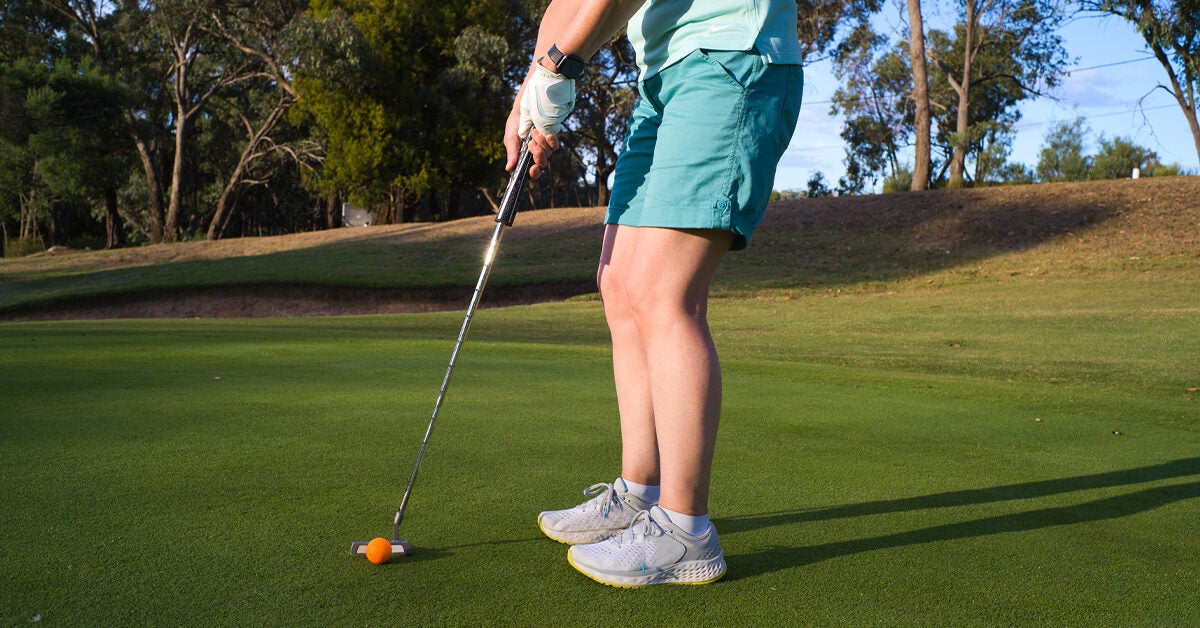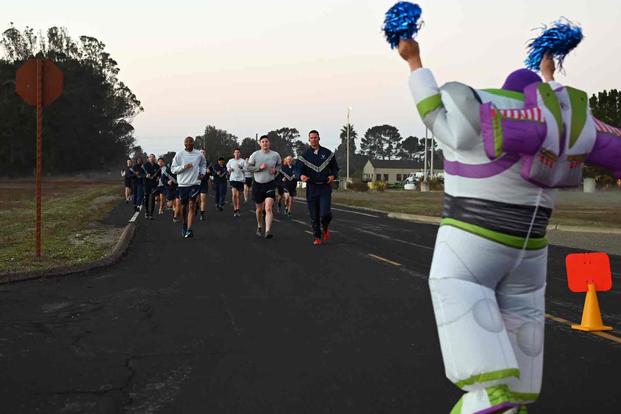Periodized Golf Workout Programs to Maximize Performance

Whether you play golf at the professional level or just enjoy a day on the golf course, a golf workout program can improve your game — regardless of your overarching goals in the sport.
The best golf training programs take a seasonal, periodized approach to your fitness, so you’re targeting specific goals in-season while allowing ample recovery time to get out on the greens.
This article breaks down everything you need to tee-off on your golf fitness routine.
Golf performance depends primarily on your ability to transfer power from your hips, legs, and core into an accurate and powerful swing to drive the ball as smoothly and cleanly as possible.
While a golf swing may intuitively look like an upper-body movement, research has shown that a great swing requires a combination of coordination and power across all the different muscles in your body (
Recent golf research found correlations between measures of upper body explosive power and the average drive distance, supporting the idea that upper body power is a key factor in the most explosive movement in golf — the drive off the tee (
Older research from 2013 found that field measures of lower body power such as jump height were also associated with improved club speed and performance when hitting the golf ball (
With that in mind, a golf workout program should combine safe and effective exercises across all areas of the body. The overall goals of a golf training program should include power development and injury prevention, due to the repetitive nature of swinging a club.
As such, when performing a workout program for golf, expect to complete a variety of standard strength and conditioning exercises in conjunction with stretches or “prehab” exercises for the shoulders. You’ll also see an emphasis on rotational movement when performing core strengthening exercises.
Additionally, including aerobic and muscle endurance training is important to ensure you maintain your energy and explosive power across all 18-holes of a standard golf game.
Overall, a wide body of research supports the use of strength and conditioning programs for golf performance (
Summary
Golf workouts primarily aim to improve power and injury prevention
The best golf workout programs involve periods of different training with the goal of improved total-body power in addition to injury prevention.
The main reason for periodization training is that maximal power performance depends on increasing muscle fiber size, strength, and finally, movement speed translating into power.
Each of these goals is best focused on individually for 4 to 8 weeks before shifting to the next phase.
For professional athletes, the timing of each phase typically revolves around maximizing performance during a relatively short window of time — typically the “in-season” phase of professional play.
Given that golf is widely played by recreational athletes who do not necessarily have a strict season of play, you will likely continue playing your regular rounds of golf even in your “off-season” training periods.
If you find periodization to be excessively complicated, do not worry. Research has shown even an 8-week program of strength and power training using high-load barbell movements improved golf club swing speed in collegiate golfers (
Although your best bet for golf workouts is longer-term periodization, adding any form of resistance and power training is likely to improve your golf performance, especially if you are not already doing some form of strength and conditioning for golf.
The periodization of the golf training program laid out in this article will revolve around the following phases:
- Pre-season: training focused on muscle endurance and size, followed by strength
- Late pre-season: training focused on maximal power development
- In-season: training focused on maintaining muscular power from previous phase
- Off-season: a short period focused on active recovery with some light training
Throughout each phase, you will perform exercises to prevent injury as well as do light aerobic activity to maintain your overall endurance.
Summary
Golf programs have different phases depending on the season of play.
Follow these guidelines across all seasons of training and workouts:
- Warm up with 5 minutes of light aerobic activity.
- Perform prehab warmup exercise with focused intention on optimizing for the movement to come.
- Perform 1 or 2 lighter sets of each exercise before starting the working sets
- Select a weight for each exercise that allows you to complete the assigned number of repetitions with only one or two repetitions “in the tank.” There is no need to go to failure.
- Proper movement form is the most important consideration for resistance exercises. Never add more weight at the expense of good technique.
- Perform all exercises with a full range of motion to ensure proper flexibility development.
- Perform 2 brisk 20 to 30-minute walks per week. Alternatively, when playing golf, do not use a golf cart on at least one round per week.
Always consult your healthcare provider before beginning any exercise program.
Pre-season golf workout program
Pre-season training will involve the highest volume of training in terms of sets and repetitions to maximize your muscular endurance and hypertrophy, or muscle size.
Mid-way through pre-season, the repetitions will decrease and the relative weight for each set will increase to stimulate more maximal strength development.
Perform the following routine for 6 weeks.
Perform 8 to 10 repetitions of each exercise for three workout sets. Rest 90-120 seconds between sets.
You can perform the lower body and upper body workouts on consecutive days. Ensure one full rest day between the back-to-back days. For example, Monday/Tuesday lower/upper, Wednesday rest, and Thursday/Friday lower/upper.
Day 1: Lower body squat, core flexion
Side to side band walks:
- To perform this prehab exercise, stand in a quarter squat with a resistance band loop around your thighs just above the knee.
- Step to the side while facing the same forward direction, maintaining strength in your core, thighs, and lower legs. Perform 10-15 steps in each direction for each set. Complete a total of 3 sets.
Back squats:
- To perform a back squat, start with a barbell resting on the top part of your shoulders, behind your neck. Grip the bar overhand with both hands.
- Shift your hips back as if sitting, flexing at thip. Lower your hips down until your thighs are parallel with the floor.
- Stand all the way back up to finish the repetition.
- Perform the assigned repetitions.
Hex-bar squat:
- Start with a hex bar with the appropriate weight loaded.
- Squat down to grip each handle.
- Drive through your feet and quads to stand all the way up with the hex bar.
- Reverse the movement to finish the repetition.
- Perform the assigned repetitions.
Leg press:
- Load up the leg press machine with the appropriate weight.
- Sit in the leg press machine and place your feet hip width apart and slightly turned out.
- Unrack the weight and lower by bending your legs in a squat-like motion.
- As your thighs contact your stomach, drive your feet into the pad to reverse the motion.
- Perform the assigned number of repetitions.
Hanging leg raise:
- Hang from a pullup bar with your hands, or use hanging ab slings.
- Raise your feet and legs to at least 90 degrees while keeping your core engaged. If keeping straight legs is too difficult, you can bend your knees as needed.
- Reverse the motion.
- Perform the assigned number of repetitions.
Day 2: Upper Body Vertical Push and Pull
Prone Ys:
- To perform this prehab exercise, lie on your stomach either on the floor or against an incline bench.
- Use a very light weight in both hands, such as 2lb (~1kg) dumbbells or even your golf club held perpendicular to your body. If this is your first time performing this exercise, start without weights to ensure no neck tension.
- Extend your arms overhead at an angle so your body and arms for a “Y” shape with your palms rotated toward the ceiling as much as possible.
- Initiate the movement from your shoulder blades and slowly raise your arms while focusing on sliding your shoulder blades down and together.
- Reverse the movement with the same slow speed.
- Perform 3 sets of 15 repetitions.
Pullups:
- Grip a pullup bar with your palms facing away from you. Alternatively, use an assisted pullup machine racked with enough weight to make your pullup smooth, but still challenging.
- Pull yourself up by squeezing your lats and shoulder blades down and focus on driving your elbows towards the ground – resulting in your body moving upwards.
- Slowly reverse the movement.
- Perform the assigned repetitions.
- If performing 8-10 pullups is too difficult, substitute with the lat pulldown.
Barbell Overhead Press:
- Grip a barbell with your hands shoulder-width apart, holding the barbell at chest height.
- Press the barbell overhead until your arms are straight.
- Lower the barbell to the start position.
- Perform the assigned repetitions.
Chinup:
- Grip a pull-up bar with your palms facing towards you.
- Pull yourself up by contracting your lats and biceps. Focus on driving your elbows towards the ground, keeping them close to your side.
- Slowly reverse the movement.
- Perform the assigned repetitions.
- If performing 8-10 chinups is too difficult, use pullup assistance bands, an assisted pullup machine, or substitute with the lat pulldown. Be sure to use the reverse grip for this exercise.
Dumbbell overhead press:
- Take a dumbbell in each hand and hold them at ear height, above your shoulders.
- Press the dumbbells into the overhead position until your arms are completely straight.
- Reverse the movement.
- Perform the assigned repetitions.
Cable twist:
- Pin the correct weight on a cable machine. Stand with the cable at shoulder height, with the direction of pull coming from your side.
- Grip the handle with your arms towards the cable machine and your torso rotated towards the cable.
- Using your core, rotate away from the cable while keeping your grip until you are facing away from the cable machine.
- Reverse the movement.
- Perform the assigned repetitions.
Day 3: Lower body deadlift and lunge, core extension
Side to side band walks:
- To perform this prehab exercise, stand in a quarter squat with a resistance band loop around your thighs just above the knee.
- Step to the side while facing the same forward direction and maintaining activation in your core, thighs, and lower legs. Perform 10-15 steps in each direction for one set. Complete a total of 3 sets.
Barbell Romanian deadlift:
- Rack a barbell with the correct weight and place it on the floor in front of you.
- Keep a braced, neutral spine as you hinge forward with a slight bend in your knees to grip the bar with a prone or alternating grip.
- Squeeze your glutes and drive through the floor, lifting your back up to standing.
- Slowly reverse the deadlift by hinging at the hip until the bar is just off the floor.
- Repeat for the assigned repetitions.
Bulgarian split squat:
- Stand in front of a bench or chair. If this is your first time performing this move, skip the weights. Otherwise, hold a dumbbell of appropriate weight in each hand.
- Place one foot top-side-down on the chair behind you.
- Lower your back knee towards the ground until it is just off the floor.
- Drive through your front foot to return to the top position.
- Repeat for the assigned repetitions.
Barbell hip thrust:
- Rack a barbell with the appropriate weight.
- Sit with a bench behind you and place the barbell on your lap with a pad or protective cover underneath it. Shelf your shoulders on the bench.
- Pivoting at the point where your shoulders touch the bench, lift your hips up to raise the barbell off the ground.
- When your thighs and torso are both horizontal, reverse the hip thrust movement and lower the bar to the floor.
- Repeat for the assigned repetitions.
Back extension:
- Climb into a back extension machine and have an appropriate weight close by.
- Facing the floor, lower your torso by hinging at the hip until you reach the full available range of motion.
- Reverse the movement by contracting your glutes and returning to the top position.
- Repeat for the assigned repetitions.
Day 4: Horizontal push and pull, core rotation #2
Band pull-aparts:
- Take a light resistance band and grip it with each hand, keeping your arms straight in front of you.
- Pull the band apart until your arms are straight out to your sides.
- Reverse the motion.
- Perform 3 sets of 15 repetitions. Be sure to use a band that allows a full range of motion.
Bench press:
- Rack a barbell on a standard bench with the appropriate weight.
- Lie under the bar and grip it with a prone grip.
- Unrack the bar and lower it towards your sternum.
- Upon reaching your sternum, reverse the bench press movement by pressing the bar back up until your arms are straight. Do not bounce the bar on your chest.
- Repeat for the assigned repetitions.
Reverse grip barbell row:
- Rack a barbell with the bar on the floor in front of you.
- Using a braced, neutral spine, lower your torso until you can reach the bar.
- Grip the bar with a reverse grip, thumbs pointing outward.
- Row the bar to your chest until it makes contact with your sternum.
- Reverse the movement to complete the repetition.
Pushups:
- Get into a high plank position with hands shoulder width apart.
- Keep your core engaged and elbows angled at 45 degrees from your body as you lower your chest towards the ground.
- Push through the floor to drive your body back to the starting high plank position.
- Repeat for the assigned repetitions.
Seated row:
- Sit in a seated row machine with the correct weight pinned.
- Grip the handles with a neutral grip, thumbs pointing up.
- Row the handles towards you keeping your elbows close to your body until you reach the full range of motion.
- Reverse the movement to complete the repetition.
- Repeat for the assigned number of repetitions.
Russian twist:
- Sit on the floor with your feet on the ground, uncrossed, with a medicine ball in your hand. If this is your first time trying the Russian twist, start with no weight.
- Rotate through your torso to twist from side to side. Keep your spine long and as neutral as possible.
- Repeat for the assigned repetitions.
Once you complete six weeks of this program, you will perform the same exercises for the next six weeks.
However, in this second phase of pre-season, you will reduce the repetitions to 3 to 5 and increase the weight appropriately for the main exercises in each workout.
Rest for 3 to 5 minutes between sets.
The prehab exercises at the beginning and core exercises at the end will remain the same.
This second phase will build maximal strength and prepare you for late pre-season training.
Golf workout program for late pre-season
Late pre-season focuses on explosive power.
You will perform fewer total exercises, 3 to 5 repetitions, and five sets per exercise. The focus should be on movement speed, first and foremost.
The weight will be roughly 30 percent of your theoretical 1 repetition maximum — however fluid movement with fast speed is the focus.
The workouts will utilize plyometric boxes, slam balls, and medicine balls. For plyometric exercises you can hold a dumbbell in each hand or a medicine ball in both hands for added weight — but only do so after you are confident in the movements.
You will only have 3 workout days.
Be sure take 1 full day of rest between workouts.
Perform this routine for 6 weeks.
Day 1: Power
Band walks: See above for description. Perform 3 sets.
Bodyweight squats:
- Stand hip-distance apart with a slight toe-out position.
- Begin by hinging at the hips, as if taking a bow. Sit the hips back and bend your knees until your thighs are parallel to the floor.
- Engage the glutes and push down through the legs to drive back up to the starting position.
- Perform 3 sets of 10 with bodyweight only.
Box jumps:
- Stand in front of a box with a height between 12” (~30cm) and 24” (~61cm) depending on your level.
- Bend your knees, swing your arms back, and explosively jump onto the box, landing in a squat. This is one box jump.
- Step down off the box carefully.
Ball slams:
- Stand with a slam ball at chest level.
- Rapidly lift the ball overhead, then slam it down in front of you by explosively performing a bowing motion.
- Recover the ball and perform the assigned repetitions.
Explosive pushup:
- Assume a high plank position.
- Rapidly lower your body then quickly drive upwards in an explosive manner such that your hands come up off the floor and your upper body is briefly in the air.
- Absorb your landing with a half of a pushup — if possible, immediately continue into the next repetition.
- Perform the assigned repetitions.
Day 2: Power
Backwards ball toss:
- Start with a medicine ball or slam ball between your legs.
- Using a deadlift movement, bend down and grip the ball on each side.
- Explosively drive up and toss the ball backwards and upwards using a hip hinge drive similar to the Romanian deadlift.
- Recover the ball and repeat for the assigned repetitions.
Wall balls:
- Stand holding a medicine ball with both hands at chest height, in front of a wall.
- Take a quarter squat then explosively drive upwards and toss the ball as high up the wall as you can.
- Ideally, catch the ball and absorb the force with a quarter squat before driving into the next repetition.
- Repeat for the assigned repetitions.
Rotation ball slam:
- Stand with a slam ball in both hands.
- Raise the ball and rotate to the side as your slam it onto the ground.
- Recover the ball and perform the same movement towards the other side.
- Repeat for the assigned number of repetitions.
Day 3: Power
Jump squat:
- Begin in a squat stance with a medicine ball if appropriate.
- Take a quarter squat counter movement and drive upwards with a squat motion to jump off the ground.
- Absorb your landing with a half squat and immediately drive into the next repetition.
- Repeat for the assigned repetitions.
Rotation ball pass:
- Stand with a wall at your side and a slam ball in your hand.
- Explosively rotate towards the wall and throw the ball against the wall with the rotational force.
- Recover the ball and repeat on both sides for the assigned repetitions.
Explosive pullup:
- Grip the pullup bar with a prone grip.
- Quickly perform a pullup explosively, bringing your chest to the top of the bar. You do not have to let go but you should have a moment of “weightlessness” as you reach the top.
- Quickly lower and repeat for the assigned repetitions.
- You can substitute an explosive tempo on the lat pulldown if pullups are too difficult.
Golf workout program for in-season
The in-season phase will maintain the power you developed in late pre-season.
Keep your workouts the same but only perform a single working set with maximal effort for each exercise.
Most of your time should be dedicated to playing golf at this point, so expect to spend far less time on each workout.
Golf workout program for off-season
The off-season is the time to take it easy, however that does not mean skipping exercise altogether.
For the off-season, simply perform the first pre-season workout. However, only use 60{b574a629d83ad7698d9c0ca2d3a10ad895e8e51aa97c347fc42e9508f0e4325d} of the weight you used during the pre-season training.
The goal is to keep your movement patterns strong and maintain your range of motion while recovering from all the training and play you did previously.
Summary
Following a periodized plan will optimize your long-term performance.
If you can follow the above routine perfectly, great. However, the following are a few tips you can use if you find it too difficult.
- You can substitute easier exercises as needed in the gym — for example, goblet squats instead of back squats.
- You can combine workout days and remove 2 to 3 exercises if you do not have time for all workouts.
- Performing a reduced version of the routine in this article will always be better than skipping the golf workout altogether.
- Start with very light weight if you have never exercised before.
- Be sure to drink enough water and get adequate sleep and nutrition to maximize recovery.
A golf workout program is an excellent way to improve your golf performance independent of training on the green.
Although optimal programs will follow a seasonal, periodized approach, science supports a variety of supplemental workout programs for golf, and any amount of resistance training can benefit your golf game.
If your goal is to improve you power, endurance, and overall performance in golf, adding a golf-focused workout routine is an absolute must.







